
Location: Avondale, NSW
Established: 1927
Architect: Eric Apperly (1927) / Ross Watson (2008)
First Played: 21st Dec 2011
Last Played: 16th Oct 2016
Magazine Ratings

64 (Current)

76 (Current)
An opportunity arose to play at one of Sydney’s northern Top 100 Golf Courses, Avondale Golf Club via an open day. So my regular playing partner Joe and I decided to head out to play the course.
Unfortunately the review for this visit was never completed and published to the site. When I came across a friend, Chris, who was a member of the club, it was inevitable another visit had to occur. This allowed the journey to be published, even if it was five years after the first visit. As the photos in 2011 were of a morning game with better lighting, these are predominant throughout the article.

Avondale Golf Club Entrance
The course is home to one of the countries previous Prime Minister, John Howard, who I am told is still an active member. Just hope his golf is a bit better than his cricket bowling. Not many glamorous views are actually offered from the clubhouse, bar the putting green, due to the high density of trees on the course.

Clubhouse at Avondale Golf Club
Overlooking the putting green, the clubhouse has limited outdoor seating. Inside it feels a little overcrowded with the number of tables, especially when trying to make your way out. Must admit had the dearest beer I’ve had in a golf club. Certainly got a shock with the bill.

Avondale Golf Club Map
The club does have some facilities for practice. A large putting green in front of the clubhouse, as well as a small driving range (drivers not allowed).

Scorecard for Avondale Golf Club
Play for both occasions were from the white tees.

Hole 1 – 320 meter par 4 – Fairview
Starting the round is the easiest par 4 with a slight turn to the right. Option to lay up with an iron leaving an easier shot from flatter land or take on the bunkers to the right, but staying clear of the one left further on, to leave a short pitch to the green. The ball will run down the gentle slope from the tee.

Approach from the 1st fairway
With an elevated green, this is more severe at the front and left side, two bunkers have been placed on the right. The easier approach is from the center or left, taking these mostly out of play. Putting deals mainly with slopes from right to left. First thing noticed is the shorter grass on the green edges, which then taper off to longer rough at the end of the slopes.

Hole 2 – 157 meter par 3 – The Trap
From the easiest par 4 we move to the easiest par 3 on the course. The staggered tees, are slightly higher than the green complex. Playing through a small chute between trees, the ground leading up to the putting surface is a small incline.

Looking back from the 2nd green
Bunkers sit mainly to the left of the green, which slopes away from this side. Another is located towards the rear. This hole allows a miss right or short of the green, although being right will see recovery shots play to a green sloping away. The putting surface has a small shelf at the front before rising to the main section of the green. Some good elements have been incorporated on what is a simple design, but they are effective. Two nice holes to ease you into the round.

Hole 3 – 526 meter par 5 – Land’s End
So the third is where things turn serious, being the longest hole on the course as well as the hardest par 5. With two slight turns to the left, this hole will challenge all levels of player. Trees run the entire length of the hole on the right, but the entire left leads down to a valley. Finding this means a lost ball. Take note that the fairways slope down to this side. From the tee there is a small rise which acts as the first turn to the left. Longer hitters may reach beyond the rise gaining some extra meters, but the main thing is to find the center to right portion of the fairway, to avoid playing around the large trees left.

Looking towards the 3rd green
Trees encroach from the left closer to the green, leaving a decision on whether to lay up or find the small section of fairway beyond, with bunkers scattered on either side. The further right here, the easier the approach, opening the green and potentially taking the left green side bunkers out of play. Here the putting surface is quite long and narrow, angling away to the left. A challenging hole due to its distance and fairway trying to take everything left.

Hole 4 – 170 meter par 4 – Frying Pan
Another par 3 takes us back in the opposite direction. In ways this almost feels a carbon copy of the second hole, although slightly longer in distance. The fairway rising towards the green, bunkers in the slopes on the left and a bunker on the right, but slightly forward.

Looking back from the 4th green
The putting surface is fairly long, widening towards the rear, with a slight tier change midway. Surrounds on most greens at Avondale Golf Club have short grass, allowing for various styles of shots to be made if missing the putting surface. Something that is always enjoyable. Similar in thoughts for this hole as they were for the second. Simple design but enjoyable.

Hole 5 – 375 meter par 4 – The Redoubt
Next is a longish par 4 which plays very straight and predominantly up a gentle slope to the green. A group of bunkers are located to the right, with the fairway sloping slightly in this direction. These are easily reachable from the tee and will leave a difficult approach if finding them. The fairway also narrows at this point.

Approach to the 5th green
With the green quite open, bar two bunkers to the right, making the approach can be from any part of the fairway without too much difficulty. On the rear and right hand side, the land slopes away from the green. The putting surface is quite long and narrow, with a small ridge running across the middle. Not the most exciting hole on the course with little on offer strategy wise.
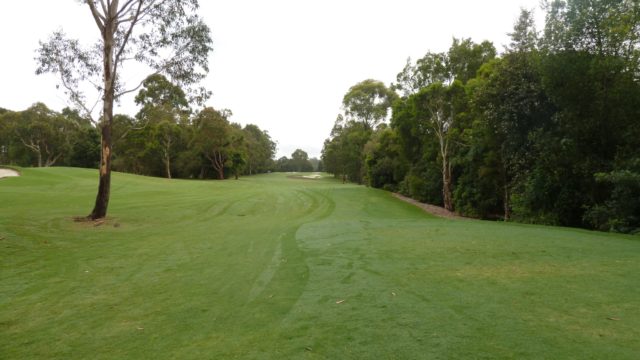
Hole 6 – 351 meter par 4 – Lookout
Slightly shorter than the previous hole but playing in the same direction, this par 4 is very similar in design. Playing quite straight up a tree lined fairway, again a gentle rise to reach the green and bunkers to the right. Actually the slope is more pronounced leading into the green and the bunkering encroaches a bit more into the fairway.

Looking across at the 6th green
Making the approach from the left will offer a slight advantage with a green side bunker covering the front right portion. Playing long will also find sand, with a tricky shot to hold the green for front pin positions. The green complex here has two distinct tiers, the right side being much higher. I found the green to be of a lot more interest. Accuracy is more the key on this hole, avoiding the trees from the tee. After a promising start, the design seemed to come to a grinding halt.

Hole 7 – 480 meter par 5 – Westward Ho
This picked up though on the 7th, a longer par 5 hole. I’m not sure on the name of the hole when it is more south than west in direction. Snaking its way towards the green, with a small turn to the right, followed by a left. From the tee a small group of bunkers are located on the inside of the turn. Carrying these will leave the best approach for longer hitters. The fairway continues to rise after these, resulting in blind shot to the green.

Running down hill to the 7th green
Finding the slope leading into the green, could assist the ball making that extra distance. If offline however could see it go past the green, in particular on the right. With bunkers either side of the putting surface, the left being almost level, whilst the right side is quite deep. Interestingly the slope of the green is leads back to the fairway from the rear. Why is that interesting when most greens are like this? After playing down slope on the fairway it gives an illusion that the slope is in the opposite direction. There are a few undulations to contend with, but getting the green speed is the hard part.
Enjoyed this hole offering risk v reward on the tee. Some will not like the possible blind shot for the second, but after playing a few times I’m sure it would be easier to pick a tree in the distance for the best line. Deception with the putting surface also contributed to making this memorable.
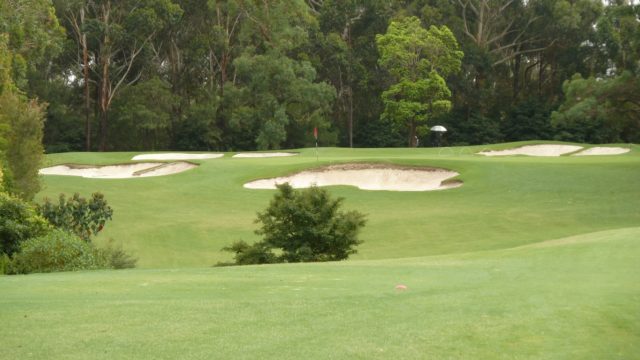
Hole 8 – 163 meter par 3 – Mayo’s
Next is another par 3. The front nine at Avondale Golf Club is unusual in that it has three par 3 holes and three par 5 holes. Not something you come across too often. This mid length hole plays over a valley to a green angling away to the left. Anything slightly short, will remain short, having such a big slope leading away from the front of the green.
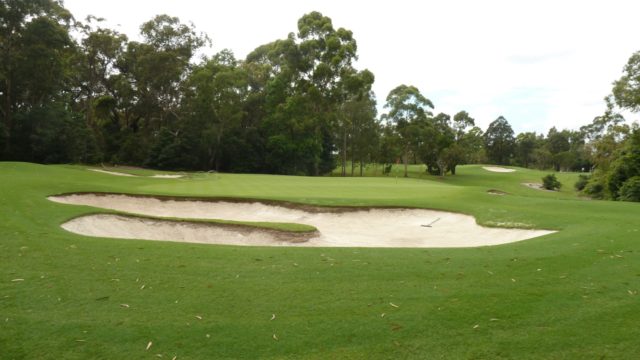
Looking back from the 8th green
Four bunkers surround the putting surface, one front, two left and another rear. There is no ideal miss here, although right side or long is probably better. The green basically slopes away to either side from the middle. Probably my standout of the par 3 holes for the front as it was a bit more challenging. One issue noticed was that the three played only varied in distance by just over meters.

Hole 9 – 470 meter par 5 – Boomerang
Finishing the first loop is a mid length par 5 which has a dogleg to the left, making it look like the holes name, boomerang. Heavily tree-lined, this fairway has a bunker sitting on the inside of the turn. Playing over will gain more distance with a down slope behind, but more interesting is playing around the bunker. With a little bit of right to left shaping, some of the fairway contours can be utilised to shorten the approach.

Looking back from the 9th green
Playing up a significant slope leaves a tough approach shot. It’s best to observe the bunker positions before reaching the lowest point of the fairway. The landing areas are quite small close to the green, making a layup a good alternate. Those missing these areas could find one of four bunkers short. There are another two beside the green which angles away to the left. A slight ridge runs along the left of the putting surface, which slopes moderately from the rear. This hole has a bit of everything, elevation change, turn, bit of strategy with some shots.

Hole marker at Avondale Golf Club
Each hole has a bronze plated marker, showing distances from its respective coloured tee. Different coloured pin flags are used to show pin position on the greens. In general it’s interesting the differing opinions on this idea. Some consider this an unnecessary advantage. I personally find it good when playing the same course on a regular basis, but can be helpful on a first visit.

Hole 10 – 338 meter par 4 – Chasm
Starting the second loop is quite a distinctive hole. Playing with a dog leg to the left, this hole has a blind tee shot, well let me clarify that, a blind landing area. With a significant slope from right to left, it is the slope near the turn you can’t see that could cause issues, if not driving through the fairway for longer hitters. Being too far left here could lead to a blind shot over trees to the green.

Hit over the chasm in the 10th fairway
A large chasm is found midway, which is blind from the tee. Hitting too far could leave quite an awkward stance on a down slope, which I can attest too. There is the option of going at the green, so it is important to work out the strategy from the tee and executing correctly. The green has one bunker sitting to the left, whilst the putting surface slopes from the rear with a slight tier change. Good strategic hole offering a bit of risk from the tee, although some will hate the blind shot. Definitely one which needs to be played multiple times to find the holes nuances.

Hole 11 – 133 meter par 3 – The Crossing
Unusual to find the shortest par 3 also being the hardest of its type. There is quite a bit of a walk between the 10th and 11th holes. You also pass by the 19th hole which can be brought into play when necessary. A shot across the entrance road into the club is required to reach the green. The large ferns to either side give a forest feel on this uphill hole.

Looking back from the 11th green
Two bunkers are found out to the left, with another at the rear. A few mounds and swales are also found on the surrounds. Sloping predominantly from the rear, the putting surface is quite wide, also containing a few ridges and changing slopes at various points. One thing I like about the hole is part of the green is still visible, even though the hole plays up a large slope. There is ample room to miss the target short or right, so it is not overly penal.

Hole 12 – 348 meter par 4 – Red Gum
Hitting back towards the clubhouse is this mid length par 4. It plays quite straight and will tempt people to hit the driver. This brings into play the solitary fairway bunker to the right and the narrowing fairway beyond. There is a much larger portion short of this for those playing safe. Ideally the longer you are to the left, the wider the opening into the green.

Approach to the 12th green
Four bunkers surround the green complex which angles away to the right. Two are short and right, with the others towards the rear. This creates an opening on the left side to bring the ball in. Not the most difficult putting surface on the course, being relatively flat, I remain undecided how I feel about this hole. Being a very straight hole over flat land certainly doesn’t appeal, but it entices you to play a riskier shot to gain the best angle into the green.

Hole 13 – 347 meter par 4 – The Downfall
Another mid length hole plays away from the clubhouse for the last time during the round. Similar in length to the 12th, this hole plays with a very slight turn to the left.
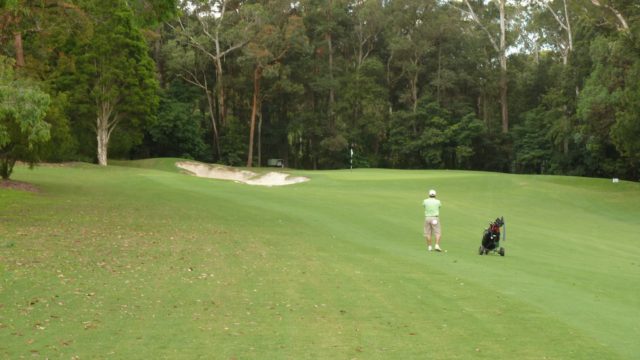
View of the 13th fairway
At around 120 meters out, you find the fairway falling away, then rising near the green. The ground here slopes left to right, which also sees the left green side bunker lips higher than the putting surface. Another hole which is not really a standout with not a lot on offer.

Hole 14 – 489 meter par 5 – Crescent
Starting the run away to the most southern section of the back nine, is the easiest hole on the course. This longer par 5 plays with a turn to the left. From the tee a small rise is in the distance just before the turn, at which point it is predominantly down slope to the green. Three traps sit on the outside of the turn, but those able to shape the ball right to left, can take advantage of the contours short of these to gain further distance.

View from the 14th fairway
Cross bunkers are found short of the green, bringing in some risk for those trying to reach the green in two. There are limited areas to miss beyond these with further bunkers coming into play. The putting surface slopes away to the front and rear, from a slight ridge through the middle. An interesting hole, which can be played a few ways, offering rewards for those who take on some risk. It is fair for all levels of player with decent width on the fairway, but also requires some skill on the green, if in the wrong portion.

Hole 15 – 148 meter par 3 – The Outcrop
An unusual little hole which requires a carry over some of the natural rock found on the land. Quite scenic, but punishing for those who don’t hit a clean shot, playing from the tee is almost like hitting through a wide chute.
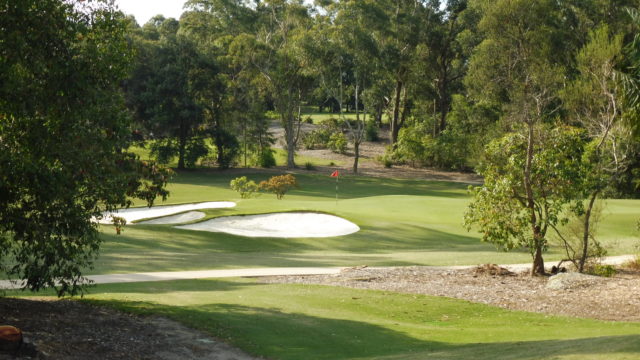
The 15th green seen from the 14th fairway
Two bunkers sit at the front of the green, although some short grass is available short of this. With a long, but narrow putting surface, the green complex sits slightly raised. A small swale sits to the right, although left or long will leave a difficult recovery shot, as the slopes are much stronger away from the green. Certainly a scenic hole requiring a hero shot to get over the forced carry, I did like the design around the green, which had distinct areas to miss without being too punishing.

Hole 16 – 423 meter par 4 – Jungle
The last hole leading out is the longest par 4 at Avondale Golf Club. Dense trees line either side of this fairway, which doglegs to the left. Playing the tee shot from a slightly elevated position, the fairway has a slight rise at the turn, but mostly the land slopes right to left.

View from the 16th fairway
Positioning yourself center to left of the fairway will leave a better line into the green, utilising some of the slopes available running into the green. From the right the shot is much harder, leaving a narrower target, but probably ideal for players with a natural left to right ball flight. The green complex runs away steeply on the left to rear sections and is devoid of any bunkering, in fact the only hole on the course without sand. A reasonable size putting surface for the length of the hole, but will require two long shots to reach the green.

Hole 17 – 288 meter par 4 – Bob’s Nob
From the longest par 4 to the shortest par 4, this is a good testing hole. From an elevated tee the fairway slopes down to a large gully, before rising again at the green. Slightly turning to the right, trees obscure most of the green, but one of its bunkers shows where it starts. A large landing area is available if laying up, which partially joins the 18th hole. Trees and gardens beyond the fairway then separate the two holes.

Looking down at the 17th green
Two fairway traps are in the landing zone for longer hitters, where the fairway rises towards the green complex. To the right of this kidney shaped putting surface, the land falls dramatically away, where another bunker awaits. Good challenging hole where big rewards can be gained, or great risk encountered.

Hole 18 – 389 meter par 4 – Home
To finish the round is the hardest hole at Avondale Golf Club, appropriately called Home. Hitting over a gully before reaching the fairway, trees encroach either side to leave a narrow chute. This is however deceiving, as the fairway is much wider than suggests. Sloping away from the tee, but also moderately from left to right, potentially bringing the denser trees into play, a dogleg is eventually found going left.

View of the 18th green
Still with everything sloping from the left, for most a long iron will be required to reach the elevated green. Traps sit on either side of the large green, with the front much deeper. The putting surface and some gentle slopes and mild undulations to contend with. Finishing with a four here is a good achievement, where I think a majority of golfers with left to right ball flights might struggle, in particular due to fairway sloping.
Looking at the course makeup:
- Hole Directions – There was a decent variety in hole directions overall, allowing for conditions to have wide ranging effects during play. But the first 7 holes ran either south west or north east, where twice, 3 consecutive holes followed the same direction. In unfavourable conditions, this could be unpleasant to play
- Hole Lengths – Par three holes where all in the mid length distance, but had a good variance in this range, but certainly could benefit by one slightly shorter and another longer to give it more of a mix. A greater range was found amongst the par four holes, ranging from short to long with a fairly even spread. Par 5 holes ranged from mid to long with the latter being the majority. The long length did have some variety, with one almost bordering on mid length
- Hole Layout – There was some mixture in how the holes played, although an overwhelming majority tended to favour turns to the left, where two shots or more were required to reach the green. This outnumbered those turning to the right two to one
In summary it was good to have played the course, in particular returning a second time, allowing some of the course knowledge learnt, to be applied. There were some nicely designed strategic holes, with a few average ones sitting in between each nine. They also seemed to be consecutive holes, which probably made them stand out a lot more. The course seemed a little out of balance overall, not so much in the two nine loops, but hole directions (turning left a majority of the time) and also routing, the first seven going in one of two directions.
Most of the short par four holes stood out to me (1 & 17), offering some risk or reward with shots. Two of the standout par 3 holes were 8 and 11, both asking a bit of the tee shot but allowing some forgiveness (obviously depending on the pin position). I especially like the use of fairway contours on a few of the holes, where these can be utilised to gain further distance or better positioning.
On both occasions I have found the conditioning of the course to be of a very high standard. The presentation did change dramatically however between the two visits. The lushness that appeared originally seemed to have dissipated, probably due to the extremely warm weather.
The course managed to blend in with the surroundings quite well. At times you would not know there were housing so close by, considering it is in a fairly built up area. This makes the journey a lot more pleasant.
This was an enjoyable course to play, with some nicely designed holes, but unfortunately not one of the standout courses for me. It ranks highly in Sydney and if invited, would not hesitate to play, I’ll play on a goat track just to pull the sticks out for a hit.
When initially played it was via an open day. There doesn’t appear to be any held now, so this is not an option to utilise. How to play at Avondale GC:
1. Be invited by a member
2. Participate in a corporate golf day held at the club

